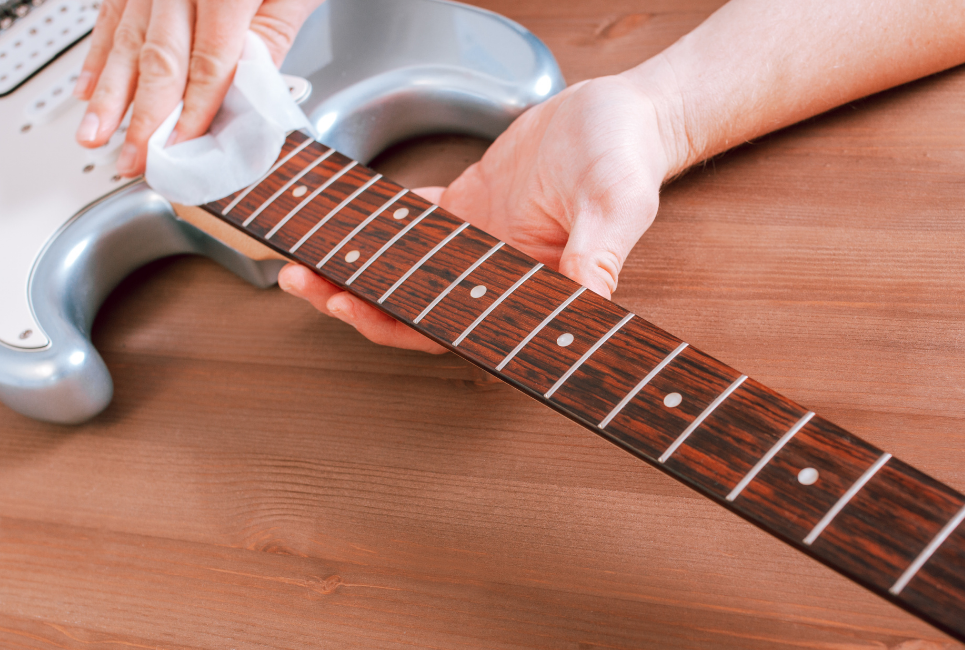You can use several oils on your guitar, such as linseed oil, baby oil, lemon oil, and many others.
Oils are everywhere, the world is running on oil, but did you know that it also has a major part to play in the overall functioning of your guitar? Well, you’d be amazed to hear that there are several oils that can actually help you maintain your guitar properly.
It is always suggested to keep your guitar well protected. The interior raw surface of the guitar demands a lot of care. May it be fingerboard, bridge, neck, or any part of the guitar, they all demand proper care for functioning flawlessly.
When you do some serious practice on your guitar, its condition makes it evident to the people around. The build of skin, sweat, and dirt surely becomes prominent and seems untidy.
Coconut oil, baby oil, lemon oil, and many others can be useful to use on your guitars, you just need to know the right way to do it.
Surfing on the internet, I found that the majority of people around the world actually use this technique to clean their guitar.
Some people apply a few drops of oil on the guitar with their fingertips and rub it off with a towel after a few minutes. Wood components on the guitar demand it the most.
Sometimes you travel from place to place with a guitar hanging on your shoulders, changing weather, dirt, and many other factors are responsible for affecting the components of a guitar.
In such situations, people usually maintain a light routine of oiling their guitar to protect them from the changing conditions.
What Oil Can You Use On Your Guitars?
The main concern is choosing the right oil for your guitar. There are a variety of oils available in the market, and the preferences of people are surely different from the others. Depending on the material of the guitar, different oils can be chosen.
Here’s a list of common oils that people use on their guitars (not all of them are recommended):
| Can use for guitar | Benefits | Target parts | |
| Baby Oil | Yes, only if its mineral oil based. | It is a non-drying oil, which means it won’t harden up with time and create trouble for you. | Fretboard,
Strings |
| Coconut Oil | No | It can’t be used as it becomes solid at room temperature. | Only Neck if needed. |
| Lemon Oil | Yes | It does not become solid that easily and can be absorbed by the wooden parts. | Neck,
Fretboard |
| WD40 | Yes, but only on strings. | It is effective in cleaning the metallic parts of a guitar. | Strings |
| Linseed Oil | Yes | It doesn’t build up on the surface. It has the ability to soak into the wooden parts and can provide good finish. | Fretboard,
Neck |
Also Read: Is Tung Oil Good on Guitar Wood? (Necks, Fretboards & Body)
1. Baby Oil
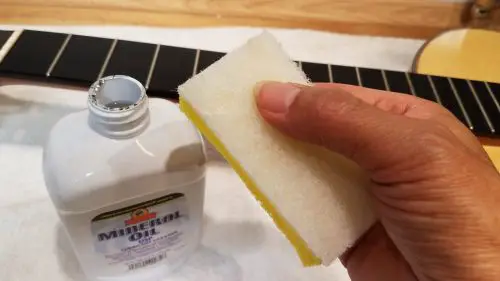
baby oils are always good to keep your guitar fresh and clean
Baby oils are recommended to use while cleaning your guitar, but only if they are mineral based. Mineral oil-based baby oils are one of the finest oils to take care of your guitar.
Mineral oils don’t have any kind of color or odor, they are often used in many skin care products, as they are the byproduct when crude oil is refined. It is a fine oil to smoothen or clean the fretboard, neck, or even the strings of your guitar.
This oil can also protect your guitar from excessive scratches, as it makes the surface more smooth, and adds a good texture to the wooden part of your guitar.
However, baby oil is considered a bit weak when talking about penetrating properly and soaking into the wooden part for long-term results. Yet, you can apply baby oil after a few intervals to keep the results consistent.
You can apply baby oil to the neck, body, and even the strings of your guitar. There’s no denying the fact that cleaning and oiling the guitar is surely a quick prosses, all you need is the right tool with you.
Before you apply oil to the fretboard, it is always suggested to remove the strings. Once you’ve removed the strings, you need to use a soft cloth to remove the dust particles from the body.
If it’s pretty dusty, you might need to use a business card or something to remove the dust from closed areas.
Once the fretboard and neck are fully cleaned, use a paper towel to apply a very thin layer of oil on the body. You can also put some oil drops on the board and spread it using a paper towel.
You need to wait a few minutes to let the oil soak in the board. After it’s soaked properly, use a soft cloth to clean the remaining oil, and you are done.
2. Coconut Oil
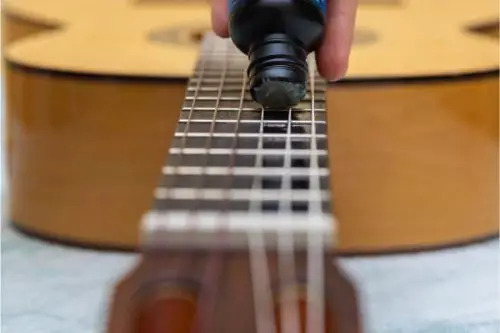
Coconut oil can damage your guitar and certainly not recommended
Coconut oil is certainly not recommended to be used on a guitar. You would never wish to damage your fretboard, right? Using coconut oil can do that pretty quickly.
If you apply coconut oil on the fretboard, the frets may come off. In the worst case scenario, it can even destroy the wood of your guitar.
It’s understandable that vegetable oils have a long life, but coconut oil has a much longer life. It’s an acidic oil, but it becomes solid and decomposes easily at room temperature.
Rather than cleaning your guitar, it can make it dirtier, as coconut oil can attract dust and dirt to the surface of a guitar.
When it becomes solid on your guitar, it is very hard to clean it off, which can certainly harm the parts of your guitar.
You can only use coconut oil to lubricate the neck of your guitar, but that is only the case when you can clean it properly afterward.
You need to keep a soft cloth to clean it properly once you’ve applied the melted coconut oil to the neck of your guitar. Don’t leave it to dry, rub it with a soft cloth to let it soak in properly.
3. Lemon Oil
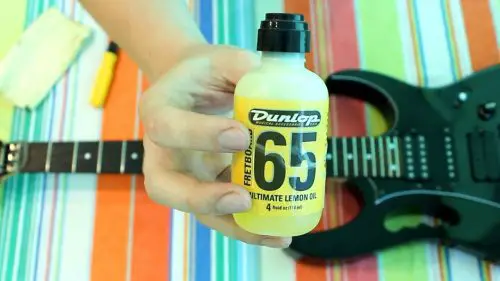
You can surely use lemon oil as there is no such bad effect on guitar
Lemon oil can be used on guitars, but there’s a long debate on it. People have sweet and sour experiences with lemon oil when used on the guitar.
However, the debate depends on which lemon oil you are using, there are several oils in the market, which certainly don’t contain any essence of lemon and are only labeled to bluff the general public.
The oil that has been extracted directly from the peels of lemons is the purest and the most suitable to be used to clean your guitar.
Acidity level has a pivotal part to play in the overall effectiveness of the oil. Pure lemon oil has one of the highest acidity levels, which are beneficial for cleaning the surface of a guitar, but only after a big break. However, if you get oils with a sustainable amount of lemon are most suitable to apply on a guitar.
You can apply lemon oil on the fretboard and even the neck of a guitar. Before applying lemon oil, you need to get your guitar free from dirt and dust particles, you can use a paper towel to do so.
Use a soft cloth to apply lemon oil gently on the neck and fretboard of the guitar. Don’t rub it too harshly on the guitar.
You need to wait for 15 minutes and allow the oil to be embedded properly in the fretboard and the guitar’s neck. Make sure that you are not using the purest form of lemon oil as it can also harm the guitar.
Excessive use of highly acidic oil can put cracks on the wooden surface of your guitar, and don’t leave the oil for more than 15 minutes. Use a soft cloth to clean it afterward.
Avoid pure lemon oil solutions, it can damage your guitar severely in no time. Plus, don’t use lemon oil too often on your guitar.
Also Read: White Gunk On Guitars: 5 Cleaning Tips & What Is It Really
4. WD40
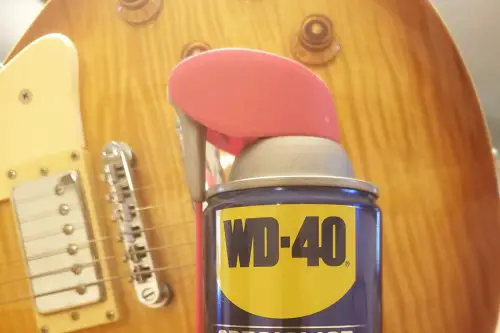
This oil is best for guitar and surely recommended
WD40 is only recommended for the maintenance of guitar strings, as it is only beneficial on metallic parts.
WD40 is a cleaning solution brand that was launched back in 1961 and has won the trust of people for decades. People often use it as a lubricant, moisture displacer, or even as a solution to prevent rust.
However, it has solvents that can easily crack and destroy wood or plastic, and this is the reason it is only applicable to the strings of a guitar.
WD40 can act as a lube as well as a cleaner. Some people also use it as a nut lube, but you can never use it as guitar polish or to manage a fingerboard.
It can completely destroy it. WD40 protects the strings from rust or corrosion, but a little mistake can result in the discoloring of your guitar, it’s better to remove the strings to clean them up properly.
It is not suitable for the body of your guitar. You can only apply it on parts such as bars, pins, and strings. Other than that, it can discolor the body of your guitar.
Strings are covered with sweat, oil, dead skin, and whatnot, it is essential to clean them up with WD40.
You can clean the guitar strings using microfiber, but don’t spray WD40 in excessive quantities as it can spread on the body of your guitar.
Clean the strings after every 3 months, or you can even clean them after 100 hours of use, totally depending on your preference. However, you need to make sure it is cleaned timely.
5. Linseed Oil

This linseed oil is one of the best and most recommended oils for smoothening your guitar fretboard
Linseed oil is one of the most recommended oils to smoothen a guitar. It is extracted from flax seeds and has a yellowish color.
Linseed oil is said to be used in paints for several years as it’s a drying oil. It does not build up on the wooden surface which makes it highly compatible for cleaning and lubricating purpose.
Some people complain that linseed oil builds up around frets and creates a problem for the future. However, there’s a particular technique to use this oil on guitars, you need to learn it before you do any kind of experimentation on your instrument.
It is suggested to get boiled linseed oil before applying it on the fretboard or guitar’s neck. Boiled linseed oil can penetrate into wooden parts much more easily and it can dry faster too. Just to protect the wood better.
Once you have the boiled toil, make sure you have a paper towel and a soft cloth with you. Clean the fretboard with a paper towel and make sure no dirt particle exists on it, and you can even remove the strings for your convenience.
Once it is cleaned with a paper towel, you can put some drops of linseed oil on a soft cloth and gently apply it to the fretboard. Make sure it is boiled, as raw linseed oil takes a lot of time to dry.
After you have applied the first layer of oil, you need to wait for a few minutes. Wait for around 5-10 minutes and apply another thin layer of oil. Now, let it soak in and dry.
It’s highly beneficial if the oil fully penetrates into the wooden part of the guitar. Give it some time to soak in and clean the remaining oil with a soft cloth. Two coats are more than enough to smoothen your guitar.


